Mekong River Cruise Adventure
By Anne Kalosh.
I woke to a rooster crowing at 4:30 a.m. AmaDara was nudged against a bank of the Mekong River, tied to trees. Beneath my balcony, a man was up to his neck in the brown water, bathing his ox. As daylight broke, houses in the forest became visible.
While we ate breakfast on board, families ashore were doing the same, squatting beside their houses that stood on tall stilts. When we strolled through the village in small groups, we met a grandmother chewing betel nuts as she minded a baby, kids jumping rope who called “Helloooo!” and a sprightly 90-year-old man who invited some of us in to his house, climbing the steep staircase with ease.

Children jump rope alongside AmaDara. * Photo: Anne Kalosh
Authentic Experiences
These kinds of intimate, authentic experiences marked my weeklong cruise through Vietnam and Cambodia with AmaWaterways. Fascinating cultures, incredible and sometimes tragic history, beautiful sights, wonderful food and unforgettable people made this Mekong River voyage one of my greatest adventures ever.
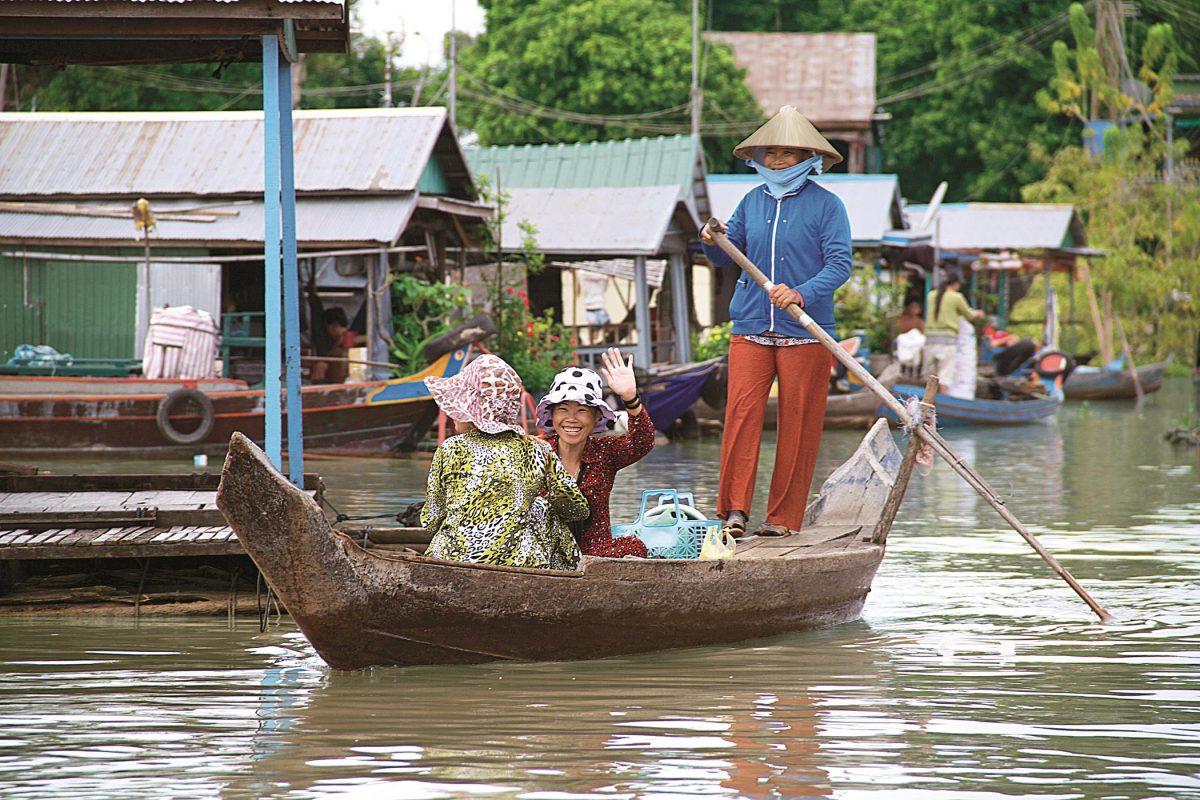
A floating village on the Mekong. Photo: AmaWaterways
We roamed markets where we were the only Westerners, got blessed at a Buddhist ceremony in a fabulous temple and rode sampans, trishaws, tuk-tuks and even oxcarts. At a one-room school in Cambodia, we helped barefoot children practice speaking English and brought their teacher pencils and notebooks.
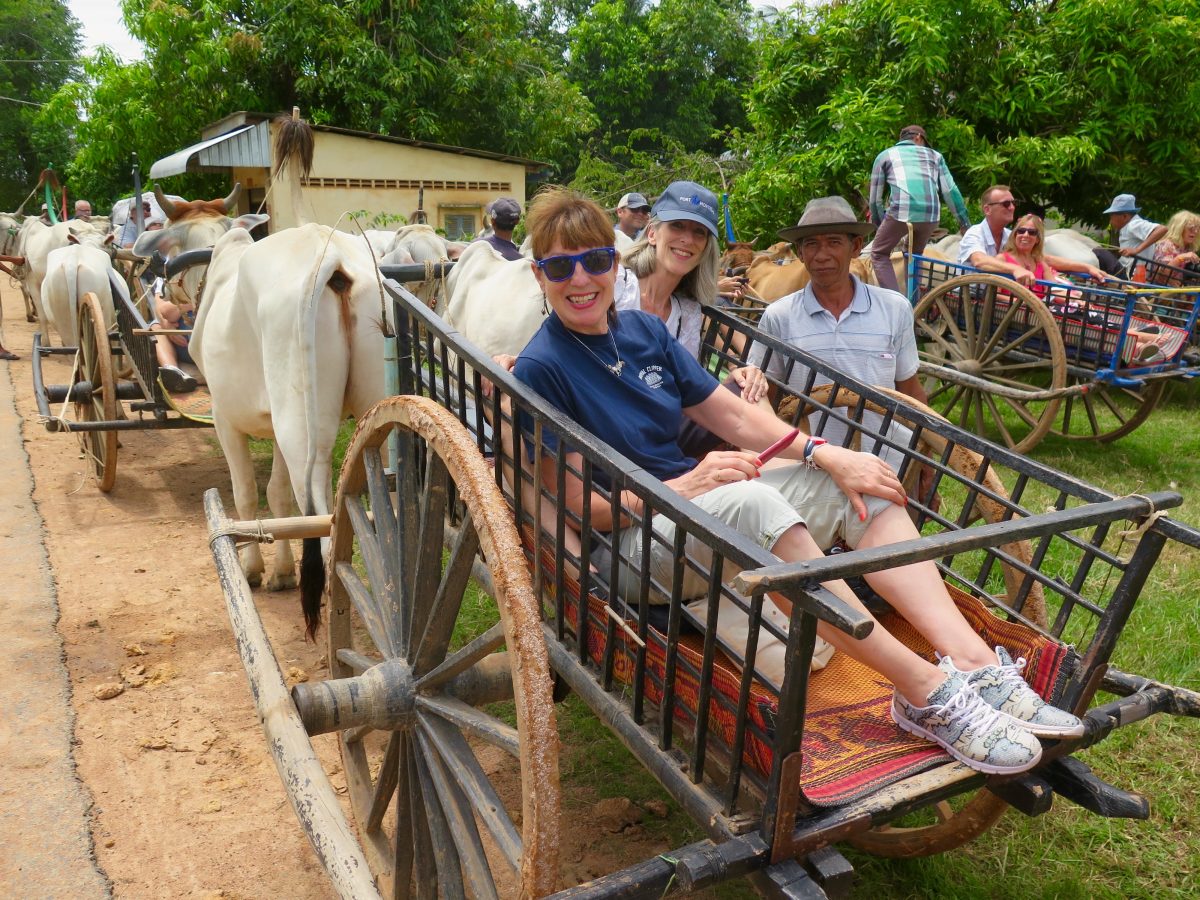
Oxcart Anne! (in blue hat) * Photo: Anne Kalosh
In Phnom Penh’s nightmarish Tuol Sleng Genocide Museum, once a prison and torture center run by the bloodthirsty Khmer Rouge, we met one of the few survivors. In Siem Reap, we joined hundreds of other pilgrims trekking through the dark to view sunrise at Angkor Wat, one of the world’s most magnificent temples.
The Mekong is home to many ancient cultures and a lifeline for trade, fishing and agriculture. But cruising is relatively new to the river, so we felt like we were experiencing something very special.
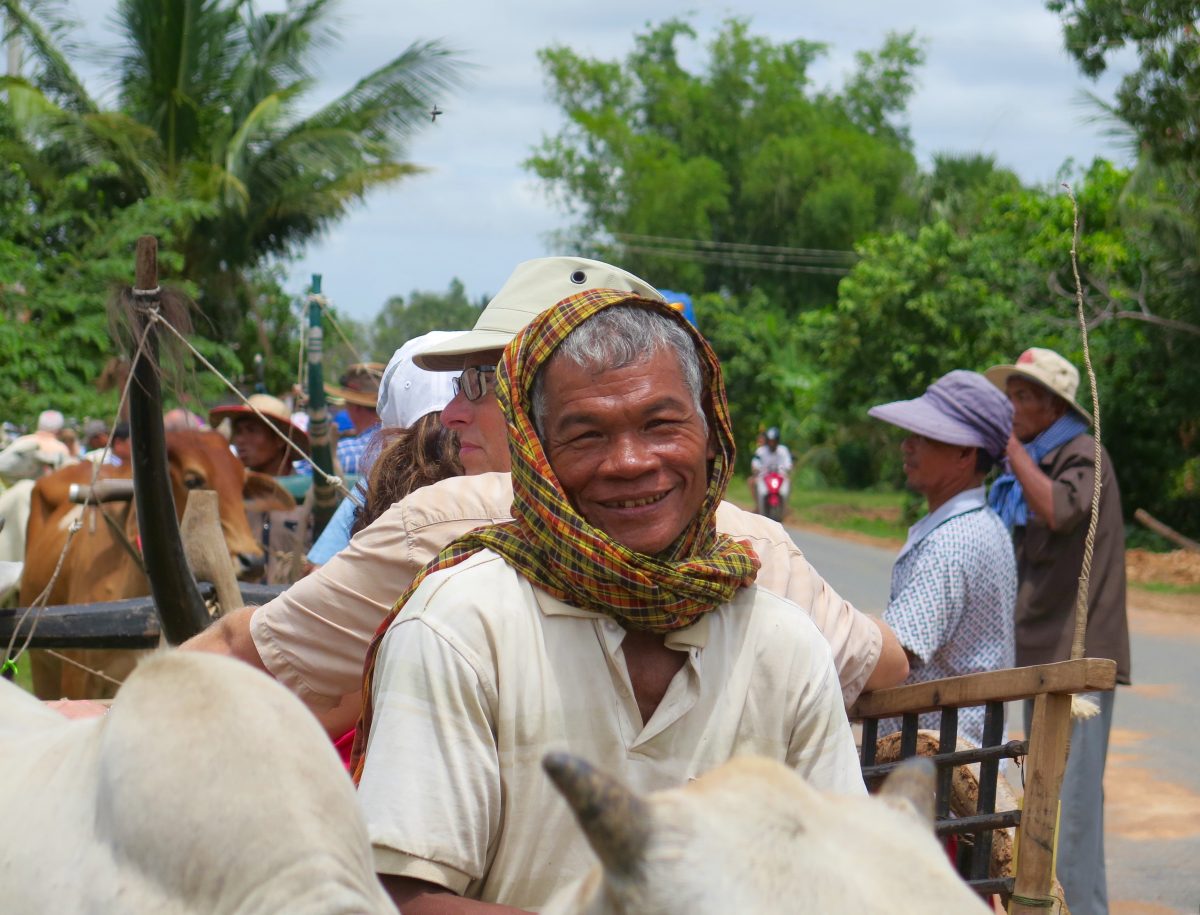
Ox cart driver in Kampong Tralach. Photo: Anne Kalosh
Beauty of a Boat
AmaWaterways’ 124-passenger AmaDara, built in Vietnam in 2015, is a beauty of glossy teak, French colonial styling and carved wood furniture.
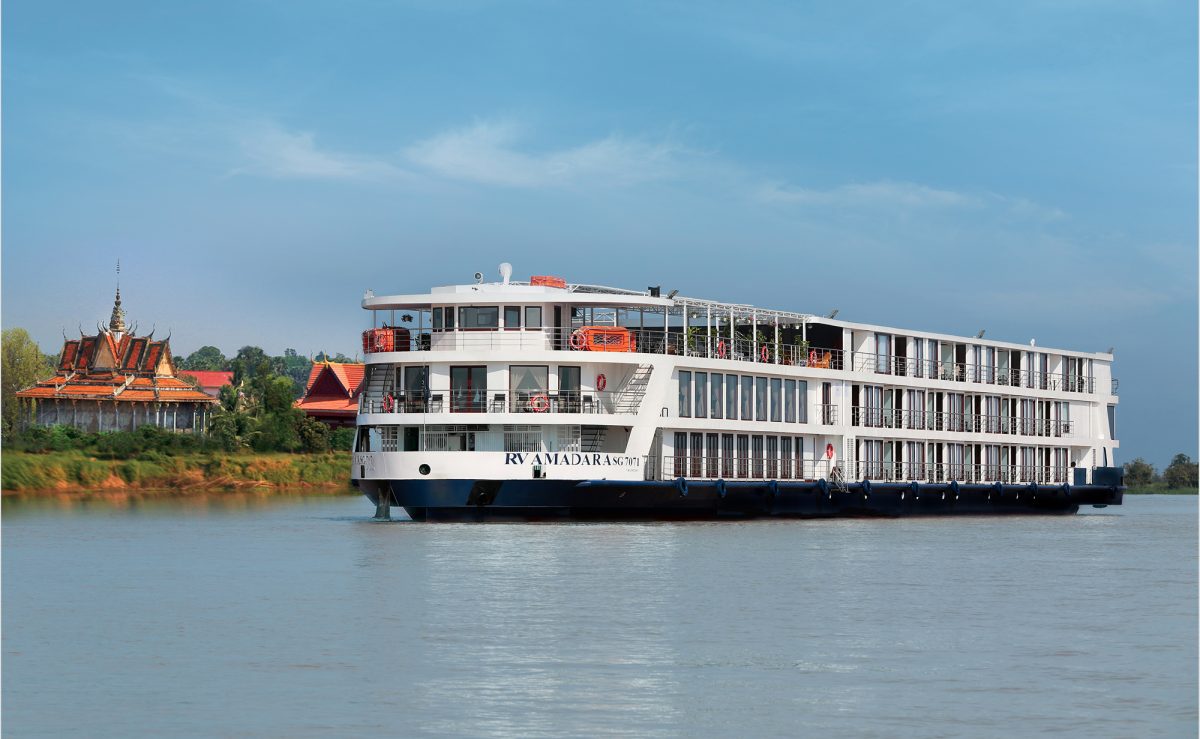
AmaDara has been plying the Mekong since 2015. * Photo: AmaWaterways
I loved my room’s dark woods, spaciousness and tall windows. It was elegant and comfortable, the big bed facing a walk-out balcony and the seating area beside a French step-out balcony.
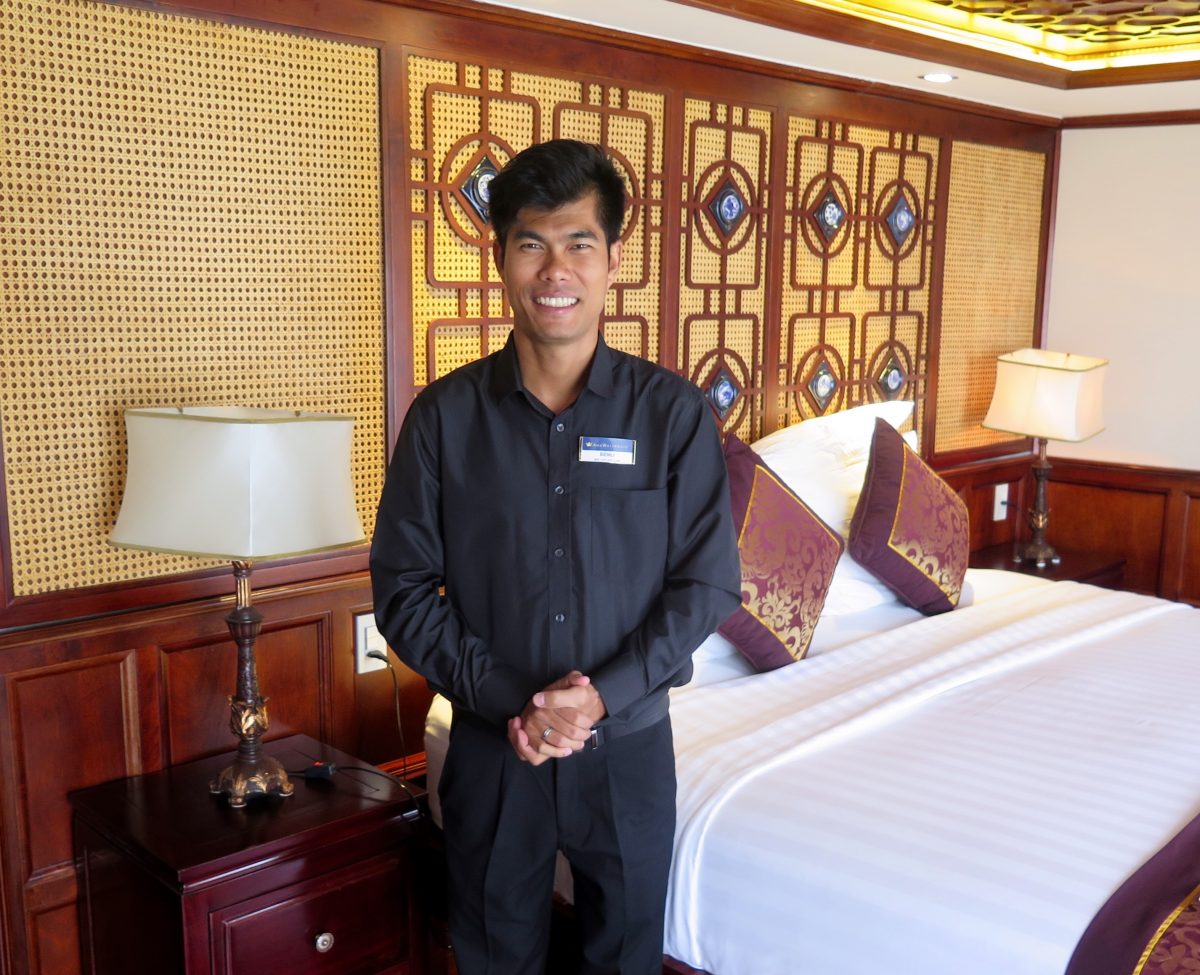
Benli, one of the wonderful AmaDara crew, showed me to my room. * Photo: Anne Kalosh
The Saigon Lounge with its bar and floor-to-ceiling windows served as a central meeting point for daily briefings, lectures and entertainment. Local performers came aboard several nights to dance and sing. Other evenings we sang karaoke, competed in a rollicking group trivia game about the Mekong and were treated to a fabulous and fun crew talent show.
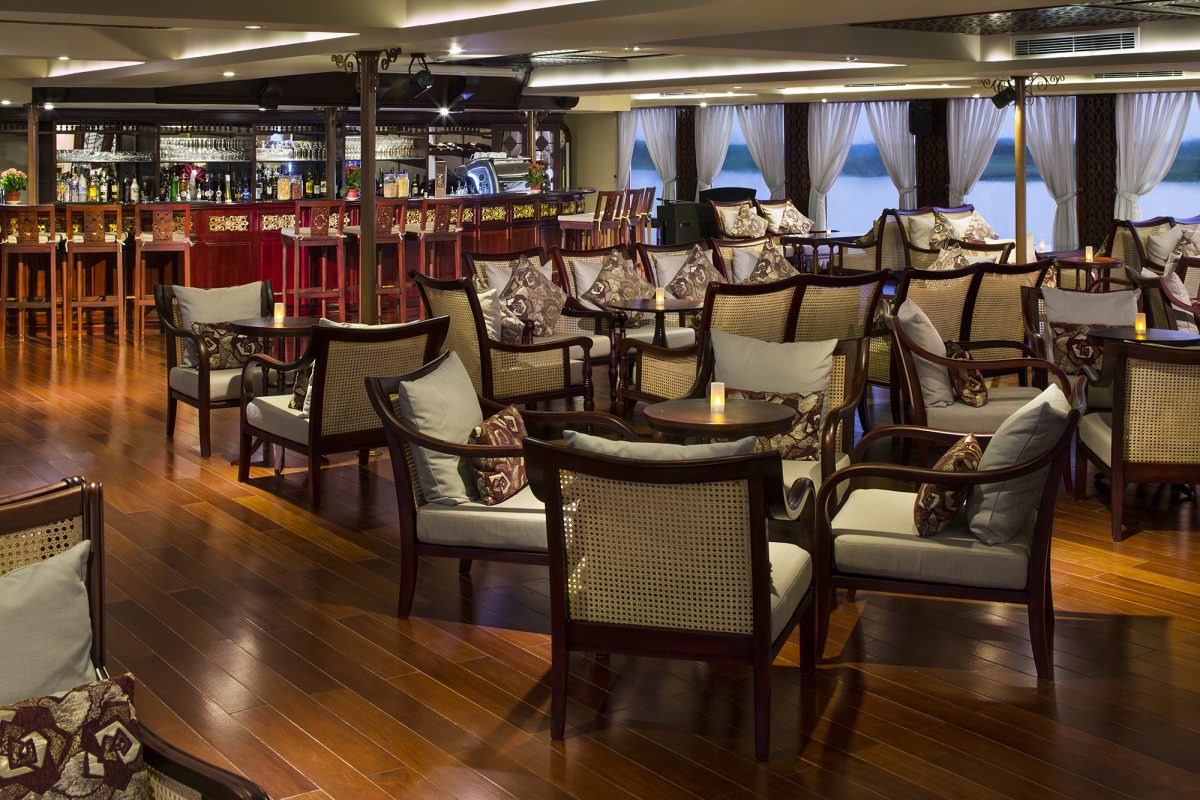
The Saigon Lounge hosts briefings, lectures and entartainment. * Photo: AmaWaterways
Local Dishes
The food aboard AmaDara was extraordinary. With Vietnamese and Cambodian chefs preparing the dishes, we enjoyed authentic meals, with some U.S. and international options always available.
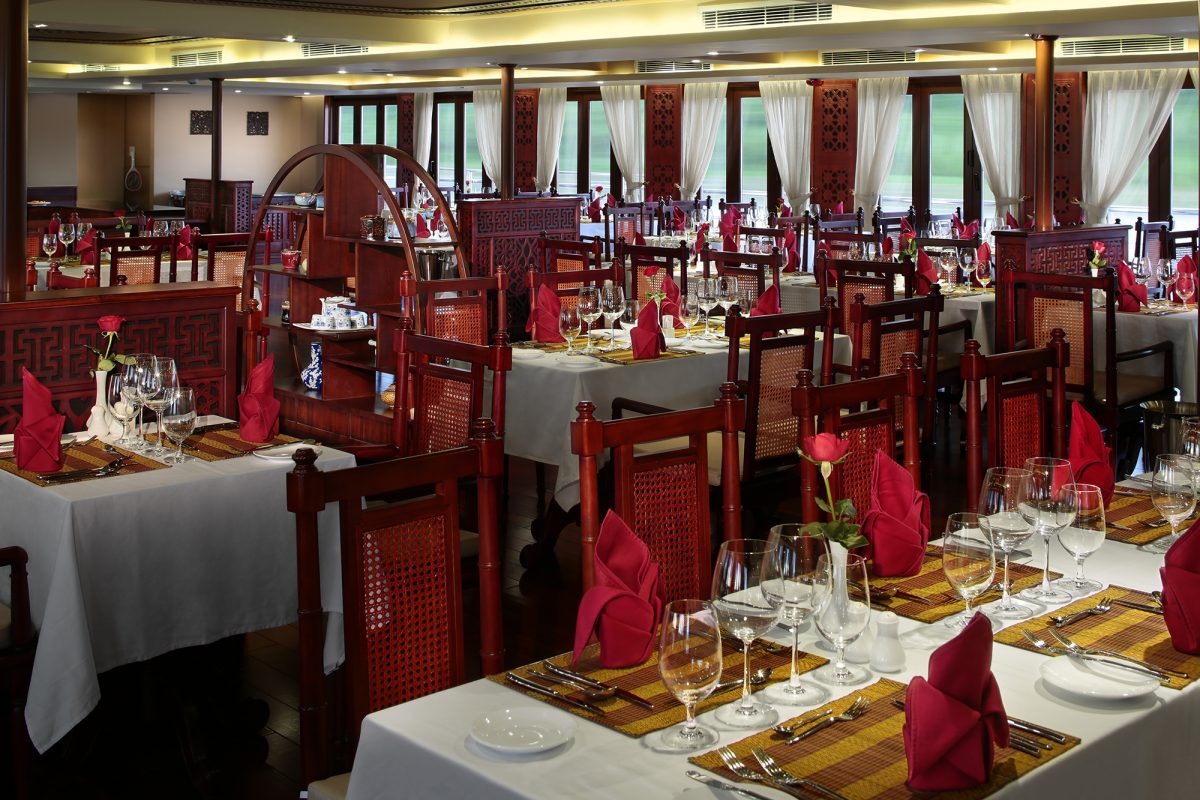
Vietnamese and Cambodian chefs prepare authentic meals in AmaDara’s Mekong Restaurant. * Photo: AmaWaterways
Breakfast included fresh fruits like mango, rambutan, dragon fruit, sapodilla, jack fruit and melon; juices, smoothies, made-to-order omelets, stir fries and pho (a Vietnamese broth with noodles, vegetables, lemongrass and chili); cereals, porridge, nuts, yogurt and pastries. There was always a bottle of Champagne for those who wished to start the day with a mimosa or, instead, addictively sweet and strong iced Vietnamese coffee.
Lunch included a salad bar, cold cuts, cheeses, seafood, fish, pasta, action-station items like steamed rice paper rolls with pork and vegetables and main courses like sweet and sour fish, potato dumplings with pumpkin sauce, pizza and burgers (meat or veggie).
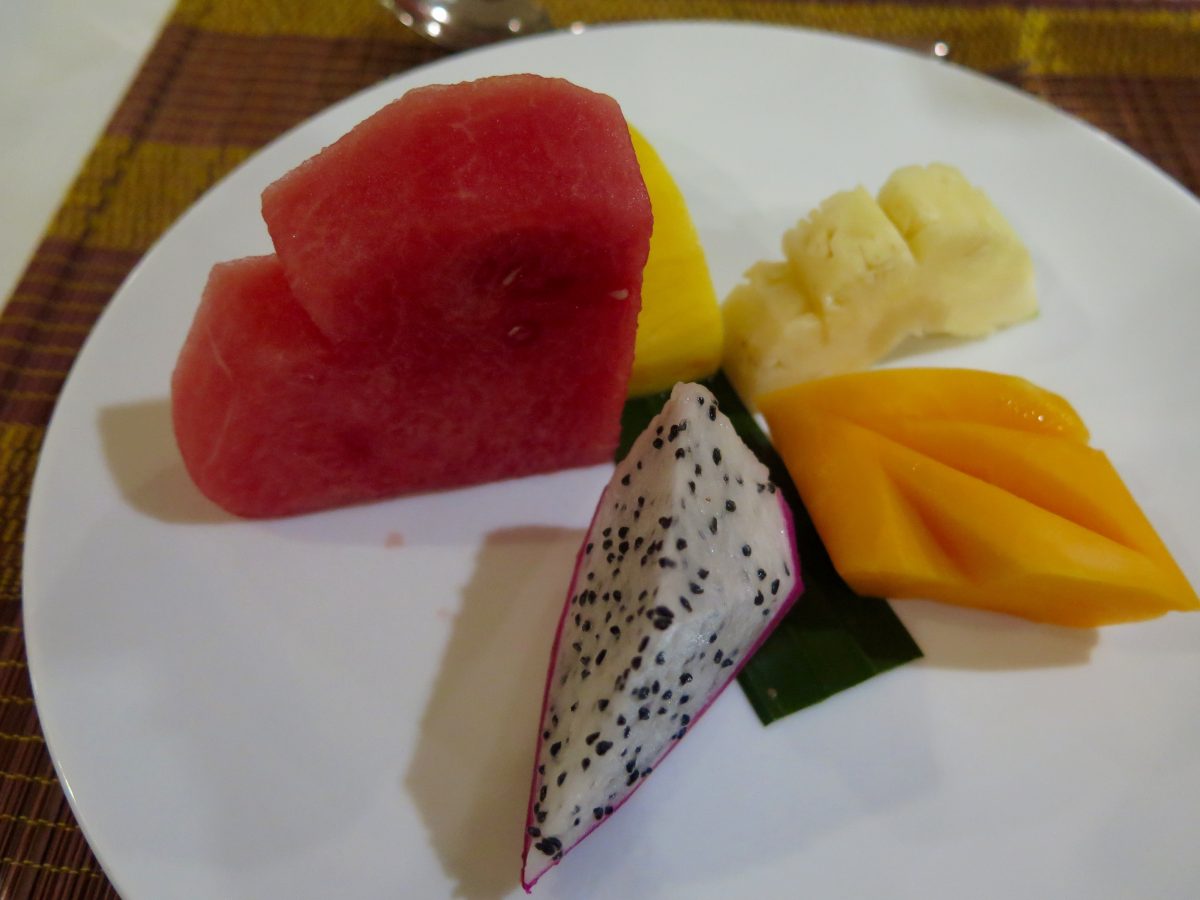
Fresh tropical fruits are in abundance aboard AmaDara. * Photo: Anne Kalosh
Dinner choices included Khmer salmon and grilled watermelon, prawn with mango, cauliflower soup with chive oil, Oriental beef consommé, Vietnamese egg drop soup with bean curd and mushrooms, sirloin steak with green pepper corn sauce, roasted turkey with taro and yam, cobia fillet with tamarind sauce and coconut rice, sesame seed tofu and tempura bok choy.
I thought the food was terrific, and it satisfied palates ranging from sophisticated New York foodies to a vegan couple who told me they found plenty of variety. Beer and wine were included at meals.
Friendly Crew, Great Guides
AmaDara is a beauty, but the best thing about the vessel was the friendly Vietnamese and Cambodian crew and the wonderful Ama guides. Tour leader Son met my late-arriving flight to Ho Chi Minh City (which most everyone still calls Saigon). On our way to the plush Sofitel Saigon Plaza, where other Ama travelers spent two nights pre-cruise, I learned Son had been a refugee abroad for several years, and a university professor. He’s the kind of knowledgeable, witty and charming leader you’d follow anywhere. And we did.
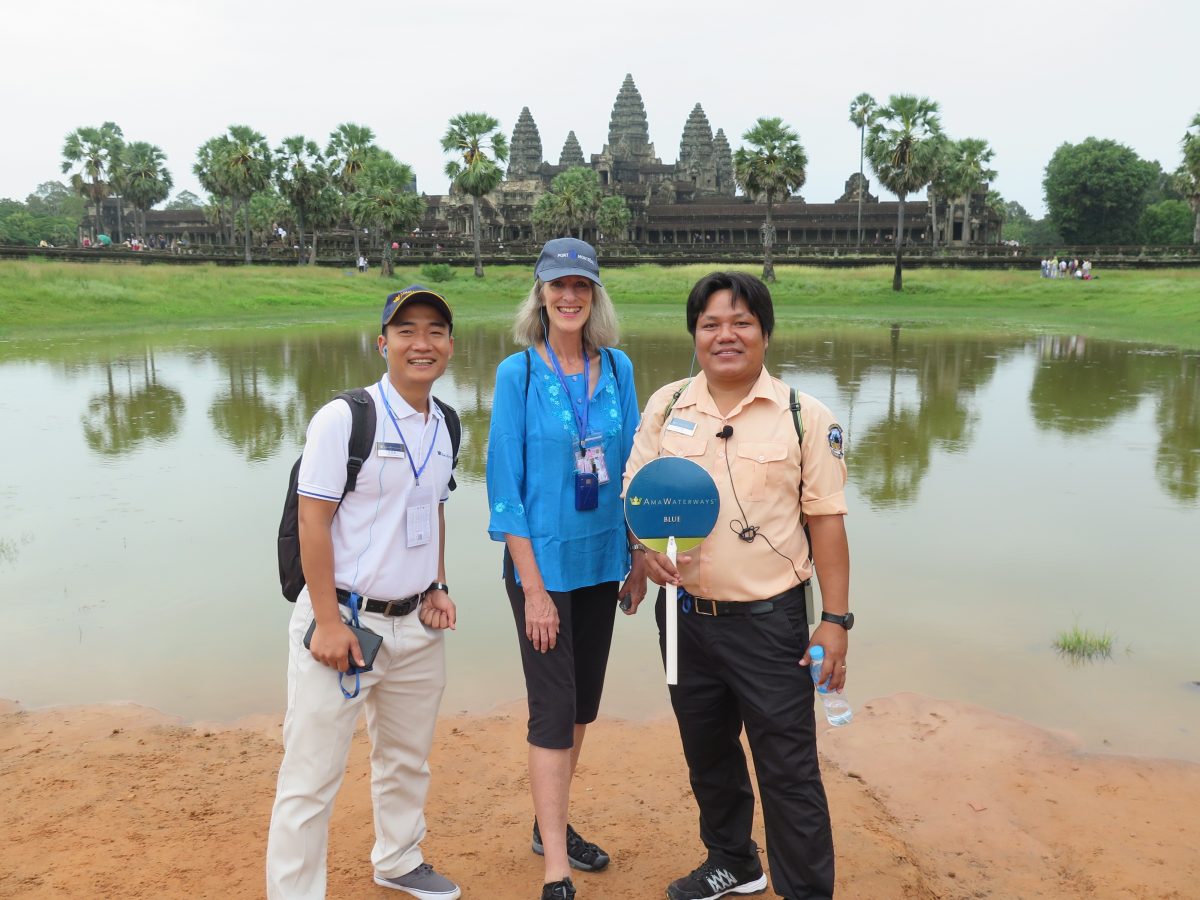
Tour leader Son, Anne Kalosh and guide Fin at Angkor Wat. * Photo: Anne Kalosh
Day 1: Ho Chi Minh City to My Tho
A City Market Adventure
The lotus embryo tea in my hotel room was a preview of the kind of drinks and foods that seemed very exotic to this American. My first city market visit was an eye-opener. There were nets of live toads, baskets of live prawns and kettles of live fish, framed collections of bats and spiders, Vietnamese coffee with brand names like Weasel and Squirrel, wood carvings (one of the Titanic) and enormous bags of cashews. A woman sat skinning an eel.
And the pointers from our Ama guides about bargaining definitely came in handy. Counter the price with 30 percent, then buy at 40 percent, they said. No eels or spiders for me. I took home fresh-ground coffee and silk scarves.
After the market our small convoy of buses drove along the wide avenues of Ho Chi Minh City, buzzing with action and lined with cafés and stands selling all kinds of things. In the countryside we passed emerald-green rice paddies and giant lotus flowers. People along the road wheeled carts piled high with coconuts, watermelons and dragon fruit.
“We like to live on the highway because of the opportunity to do business,” our guide Duy said. Two hours later, we arrived at My Tho, where AmaDara was docked.
Captain Dang Tuc stood at the gangway, impressive with his seafarer’s beard. On board, we learned that “Ama” means “love” and “dara” means “star.” We were just 87 passengers—from the U.S., Canada, Germany, the U.K., Philippines and Australia—on this early-season sailing. (Riverboats run on the Mekong from August to April.)
I was surprised by the number of families, including those with young children and teens, as well as solo travelers like me.
Our first day’s sail, to Cai Be, was short. We anchored midstream overnight. After dinner, Vietnamese musicians played traditional instruments.
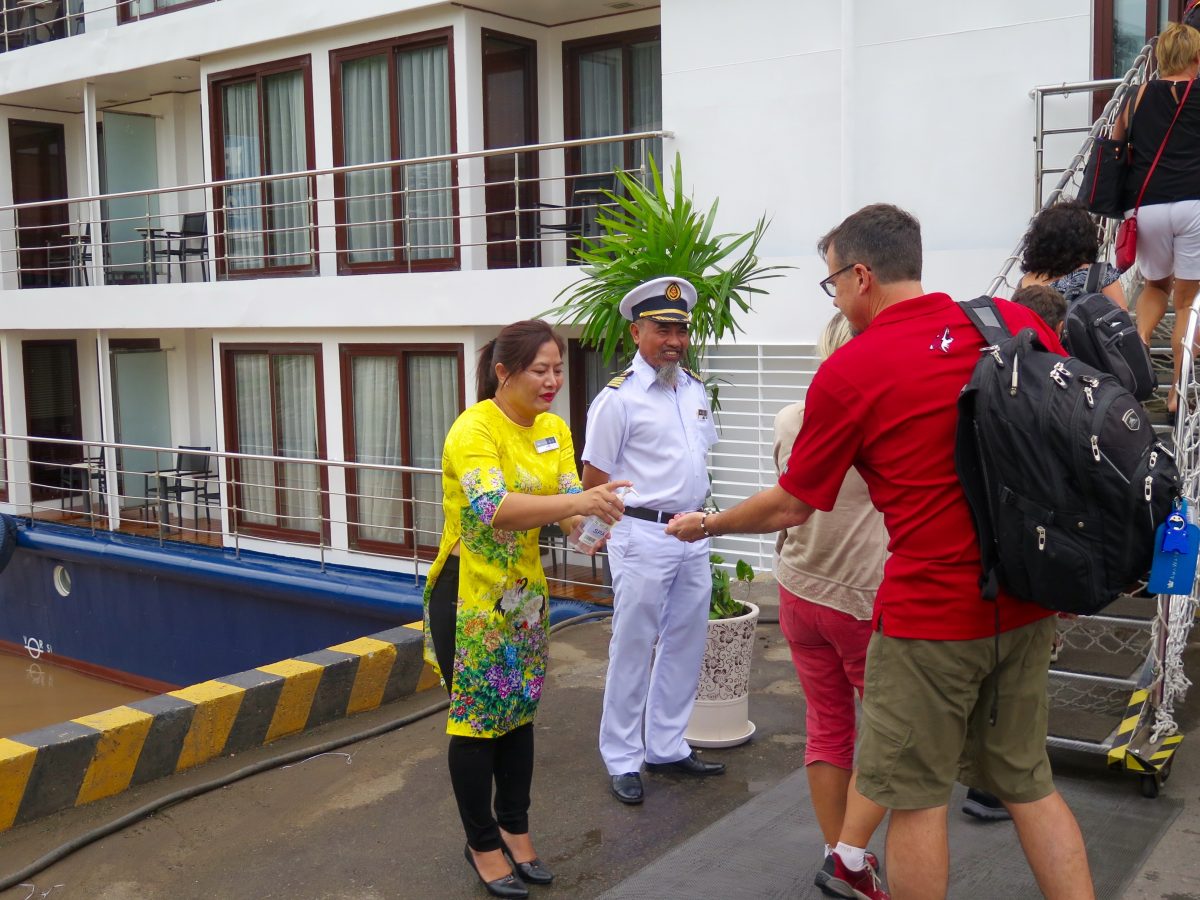
Capt. Tuc and a crew member greet embarking passengers at My Tho. Photo: Anne Kalosh
Day 2: Cai Be and Sa Dec
Floating market, Temple and Romance
Cai Be is an important agricultural distribution center, especially for fruits. To visit the floating market, we rode in long, covered sampans past colorful boats with eyes painted on the bows (a tradition said to ward off sea monsters). Many of these were live-aboards, and families strung their laundry on lines, kids played on deck and food was cooked in the open air. Many of the larger boats transport live fish in an underwater well or tank with screens to allow river water to flow through.
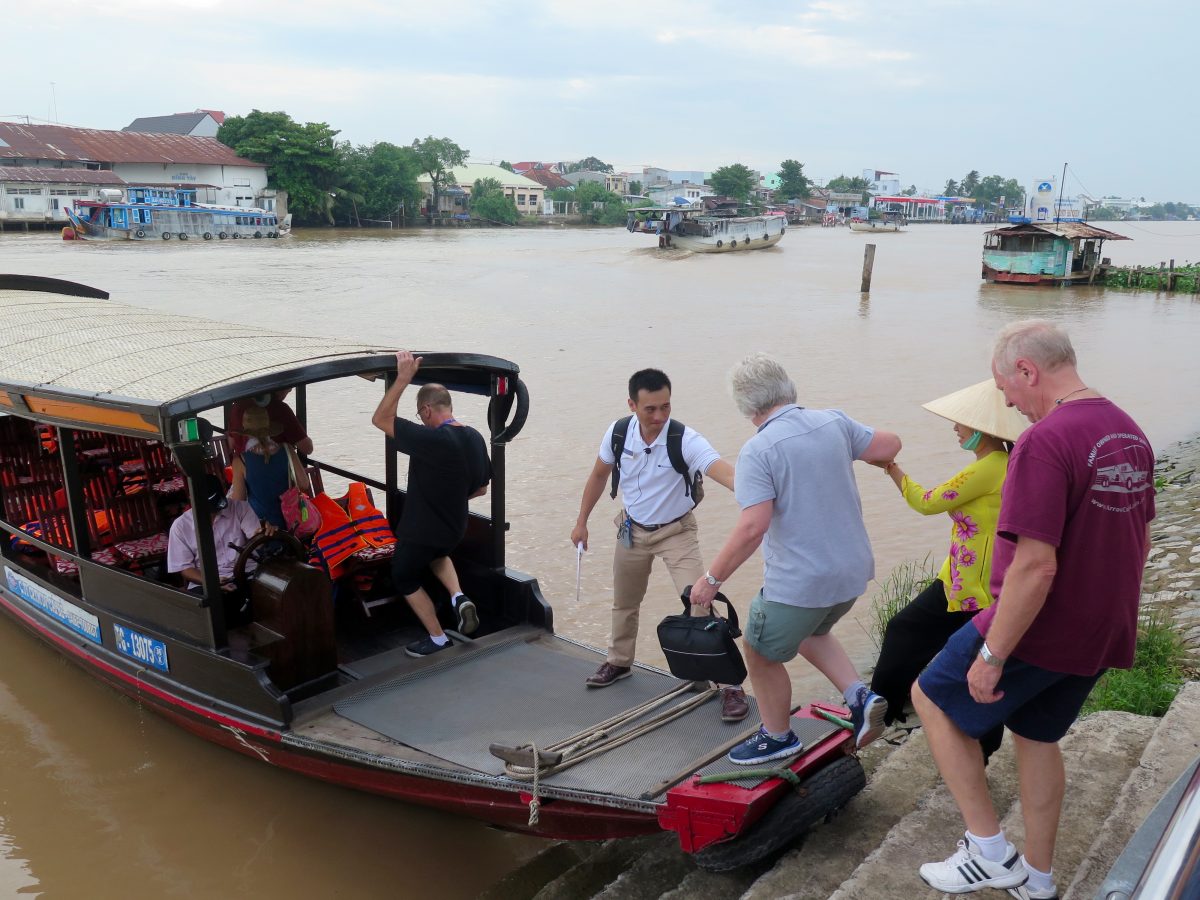
Touring the Mekong by sampan. Photo: Anne Kalosh
I saw coconut candy, popped rice snacks and edible rice paper being made in a shop that also sold cobra and scorpion wine, these creatures visible in the glass bottles. Other products included “Fat of Pythons” ointment for burns and dry skin and “Cobratoxan” cream for muscle pain.
“We eat anything that moves,” guide Duk said, adding snake is considered particularly nutritious. “We don’t eat python,” he clarified. “It’s too fatty and tasteless. We do eat cobra. We eat rats in the rice field. We eat mice. We eat crickets. Roasted crickets in garlic and chili are tasty.”
Walking along a forest trail we arrived at Kiet House, a pre-colonial home of elaborately carved wood, filled with antiques, ceramics and an altar to the ancestors.
In the afternoon, at Sa Dec, an agricultural and industrial trading center, we visited a colorful temple to Caodaism, a syncretistic religion whose symbol is the Divine Eye of God. Strolling through a market, we saw pigs’ heads split open in puddles of blood, eels and snakes, live crabs and heaps of fresh vegetables, greens and herbs.
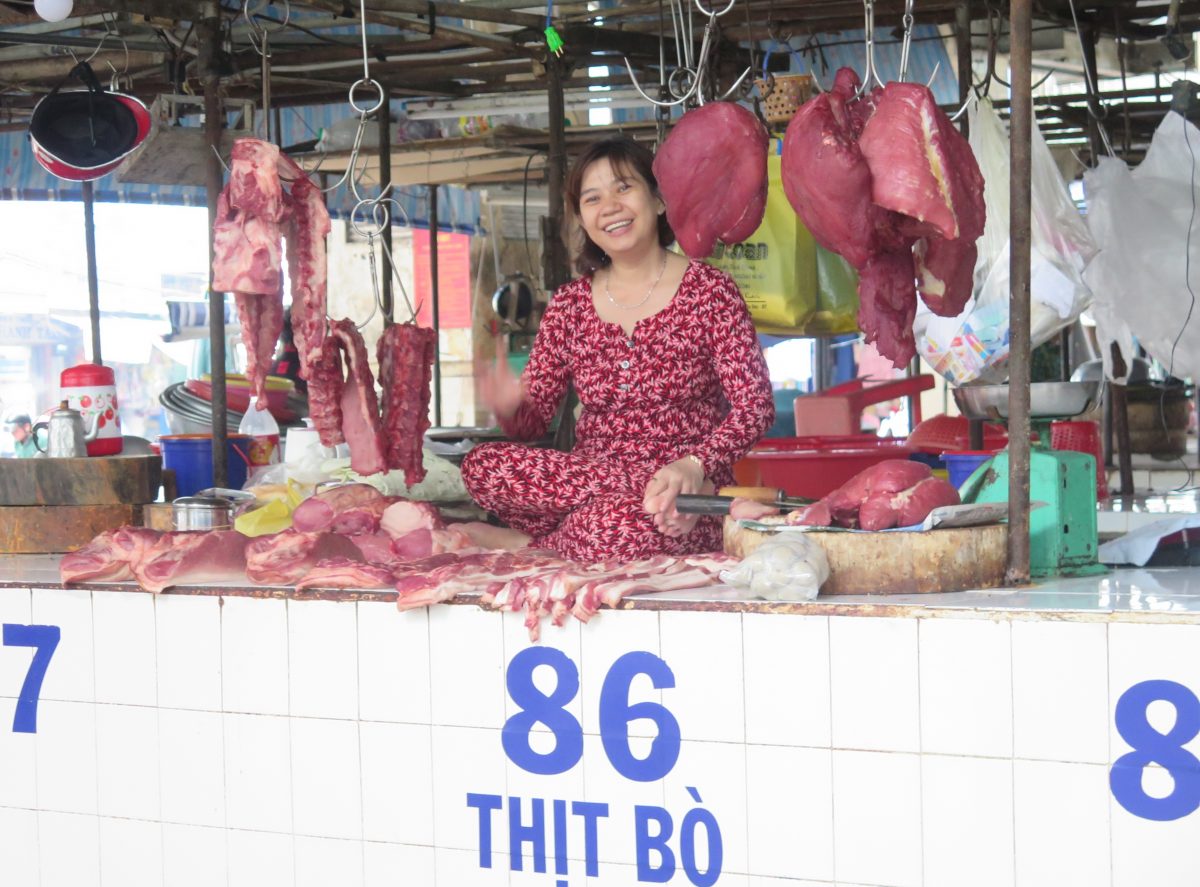
Butcher stall in Sa Dec market, Vietnam. * Photo: Anne Kalosh
The French writer Marguerite Duras lived in Sa Dec as a teenager where she had an affair with a wealthy 27-year-old Chinese man. Her novel “The Lover” was made into an exceedingly atmospheric film. We had tea at the wealthy man’s house, now a museum.
Day 3: Tan Chau
Rural Life and Riding in a Trishaw. Whee!
The sampans took us to Tan Chau, famous for its black-dyed silk. We visited a silk factory and at a rattan factory, we scooped up items decorated with hand-dyed silk threads. We learned about rural life on a stroll through Evergreen Island, our guides engaging people to tell about their homes and families. Back in Tan Chau, we rode cycle trishaws, my adept driver chatting on his phone as he pedaled away. I loved the ride!
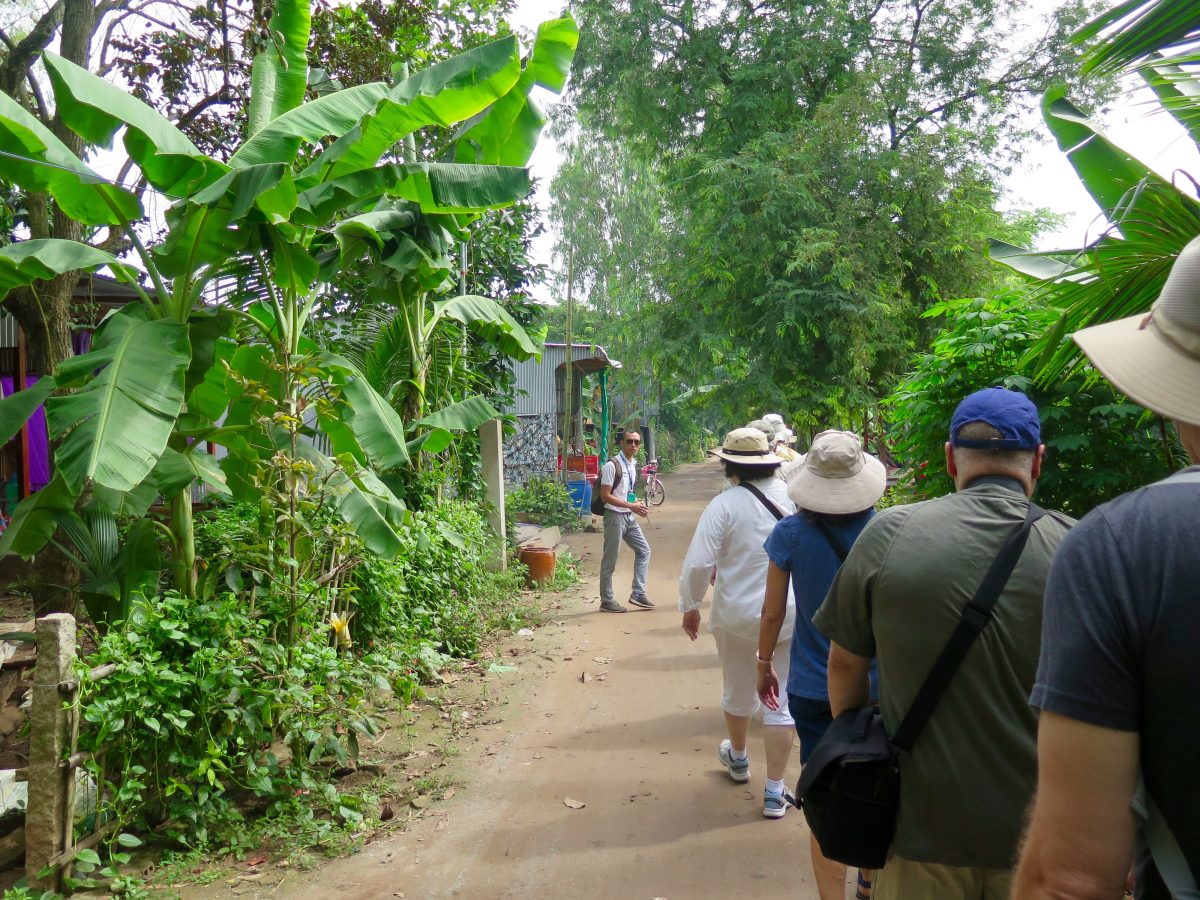
Strolling around Emerald Island. * Photo: Anne Kalosh
Day 4: Phnom Penh
Tragedy & Beauty
Arriving at Cambodia’s bustling capital, AmaDara docked right downtown, in the heart of the action. The most tragic period of Cambodian history, the 1975 to 1979 reign of Pol Pot and his Khmer Rouge regime, was a sobering start to our visit. Well more than a million people, perhaps nearly three million, were executed or died from starvation or disease. No family was spared. When our guide Fin was a baby, his father vanished and was never heard from again.
Seeing one of the Killing Fields—sites where large numbers of people were executed—was indescribably sad and horrifying. Back on the bus, we fell silent. The shock and revulsion continued back in the city at Tuol Sleng Genocide Museum, known as Security Prison 21, or S-21.
There we met Chum Mey, one of its few survivors, who wrote a book about his life and ordeal. “How do you have the strength to come here every day?” I asked.
Chum said he’s compelled to bear witness to what happened. His book sales help support victims of the Khmer Rouge.
On the bus, Fin summed it up: “That was heavy. Not an enjoyable morning, but an important one.”
The afternoon was quite different: A walk through the grounds of the Royal Palace, home to Cambodia’s king. In the Silver Pagoda thick silver tiles covered the floor and a Buddha of solid gold was encrusted with thousands of diamonds. For me, a high point was the National Museum with its incredible collection of Khmer art. The Khmer empire was a powerful state that once covered most of modern-day Cambodia, southern Vietnam, Thailand and Laos. Great builders, artists and musicians, the Khmer created monumental temples like Angkor Wat, and the museum houses many sculptures, statues and other artifacts from there.
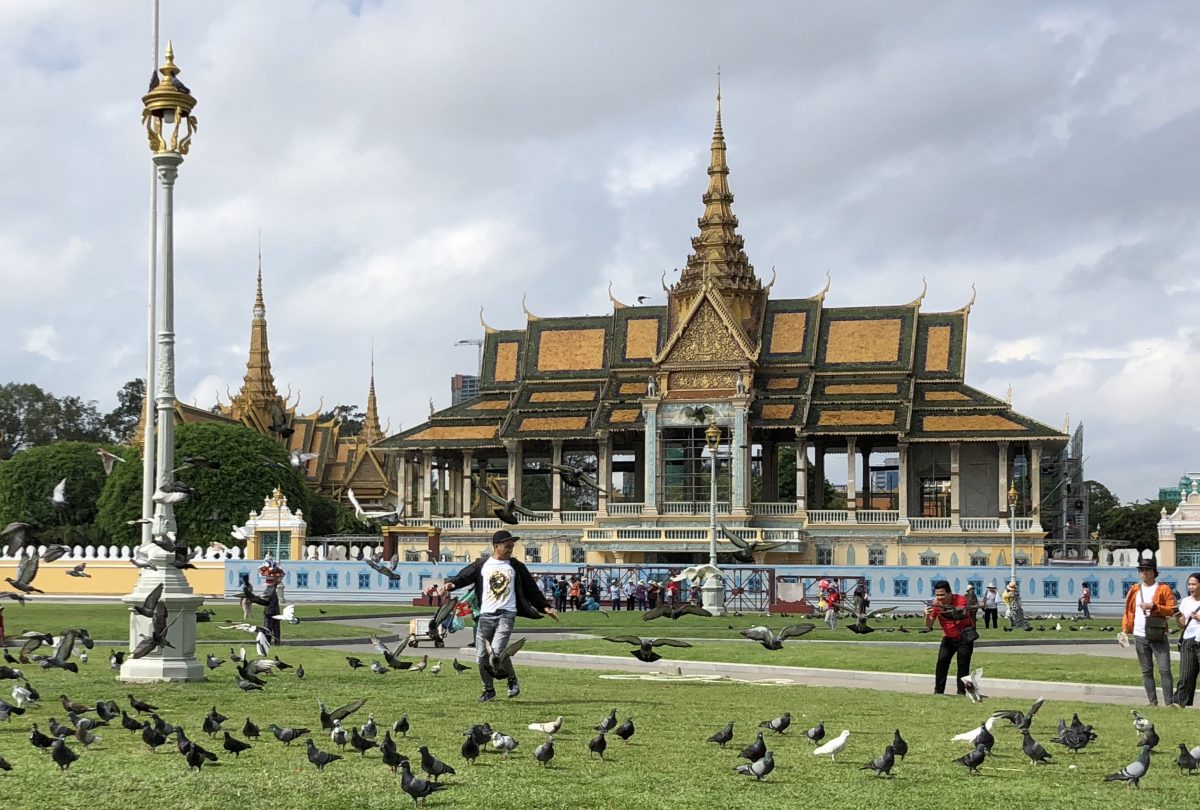
Phnom Penh’s gilded Royal Palace complex. * Photo: Heidi Sarna
Day 5 Phnom Penh, Oudong and Kampong Tralach
Buddhist Blessing & Oxcart Parade
We journeyed by bus to Oudong, Cambodia’s royal capital from the 17th century until 1866, and a place of pilgrimage. AmaWaterways had arranged a special Buddhist blessing for our group at one of the country’s largest monasteries. We sat on the floor, gazing up at the incredible neon lights, statues and paintings while monks performed the blessing.
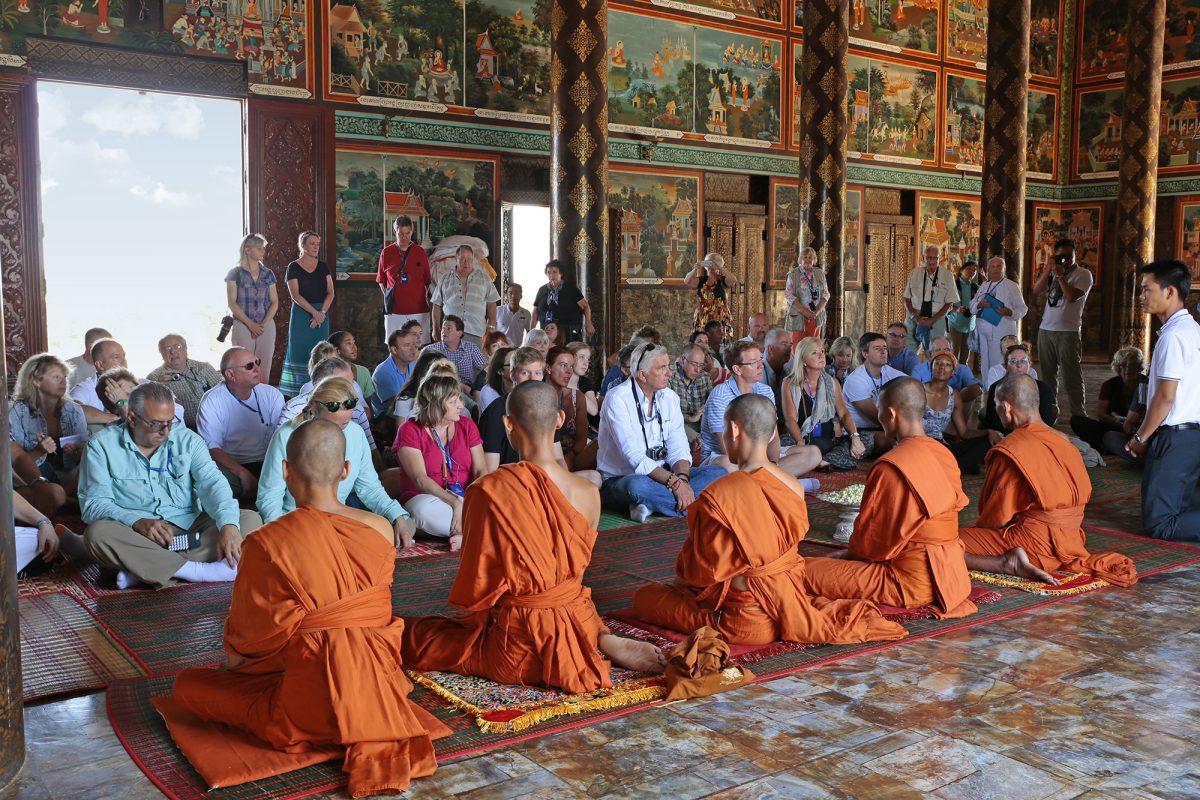
A special Buddhist blessing for Ama passengers at Oudong. * Photo: AmaWaterways
Nearby, at Kampong Tralach, dozens of oxcarts awaited, each driven by a farmer. We climbed in, two apiece. Our slow-moving parade was a spectacle followed by skipping children and women waving from doorways.
Back in Phnom Penh, we tried another typical conveyance, tuk-tuks (motorcyle-driven carts). It was fun surging en masse with all the other tuk-tuks, occasionally seeing familiar faces from AmaDara.

Buddha at Oudong Monastery, Cambodia. * Photo: Anne Kalosh
Day 6: Oknhatey
Chatting with Schoolchildren
Sailing from Phnom Penh at 7 a.m., we arrived at Koh Dach, known as Silk Island, and rode tuk-tuks through the countryside of rice paddies and orchards to see silk artisans at work and buy beautiful hand-loomed scarves.
The trip’s most heartwarming experience was visiting a school, where we paired off with the children so they could practice speaking English. I can’t forget the little boy who told me he wants to be an author.
That night AmaDara pulled alongside Angkor Ban.

School visit on Oknatey Island, Cambodia. * Photo: Anne Kalosh
Day 7: Angkor Ban & Kampong Cham
Village Visit
This was the morning I woke to the rooster’s crow. In small groups, we strolled through the village with our Ama guides. Huge oxen, “like money in the bank” for Cambodian families, according to Fin, lazed in the shade. Some walls had drawings intended to ward off evil spirits.
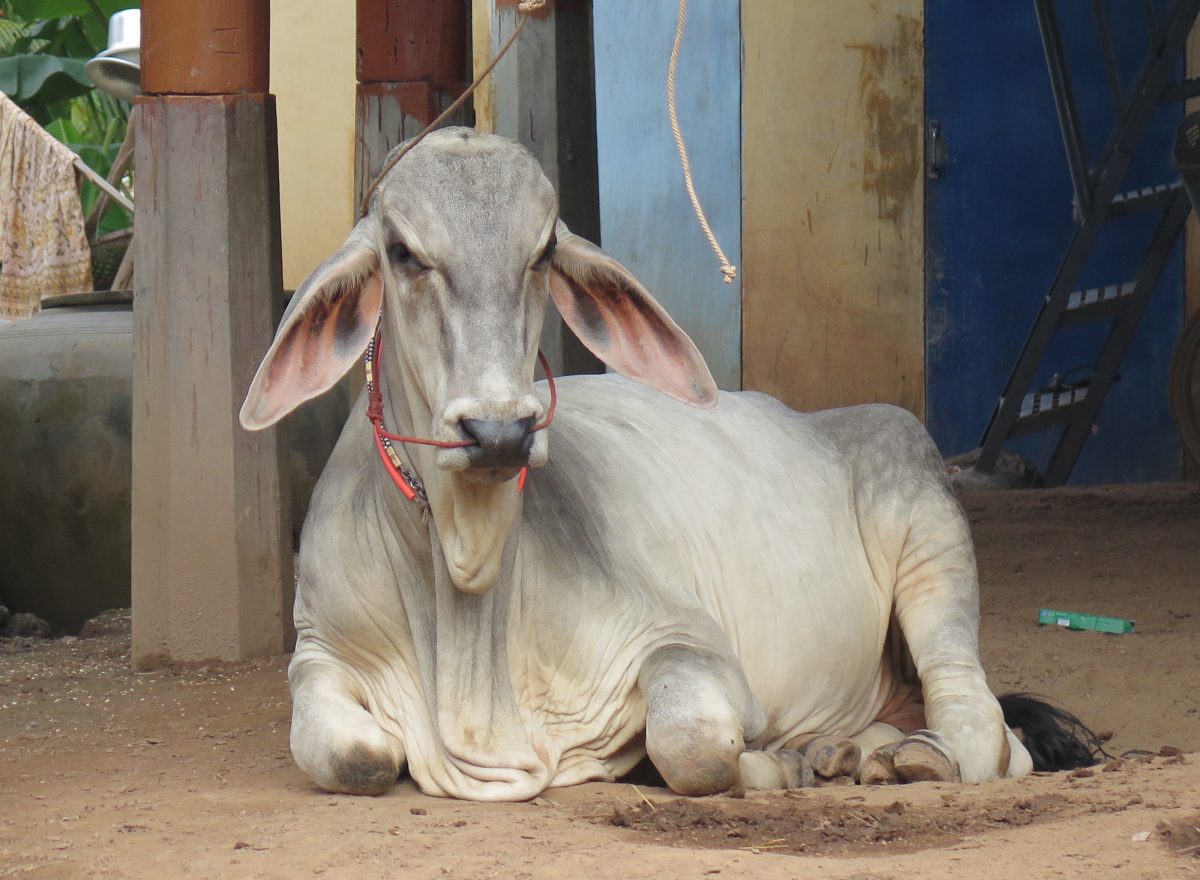
Oxen are highly valued and considered money in the bank in Cambodia. * Photo: Anne Kalosh
AmaDara cast off for Kampong Cham, our final port. We docked beside an outdoor cafe with umbrella tables. The third largest city in Cambodia, Kampong Cham appeared prosperous and busy.
Traveling by bus to Wat Nokor, we discovered an interesting temple dating from the mid-11th century. Roadside stands served duck eggs with 20-day-old embryos. Fin explained this is “Something one person eats that makes two persons happy. Get it?” I didn’t, until he winked. We saw the Twin Mountains (Man Hill and Woman Hill), the topic of a legend in which the women outwitted the men in a mountain-building contest.
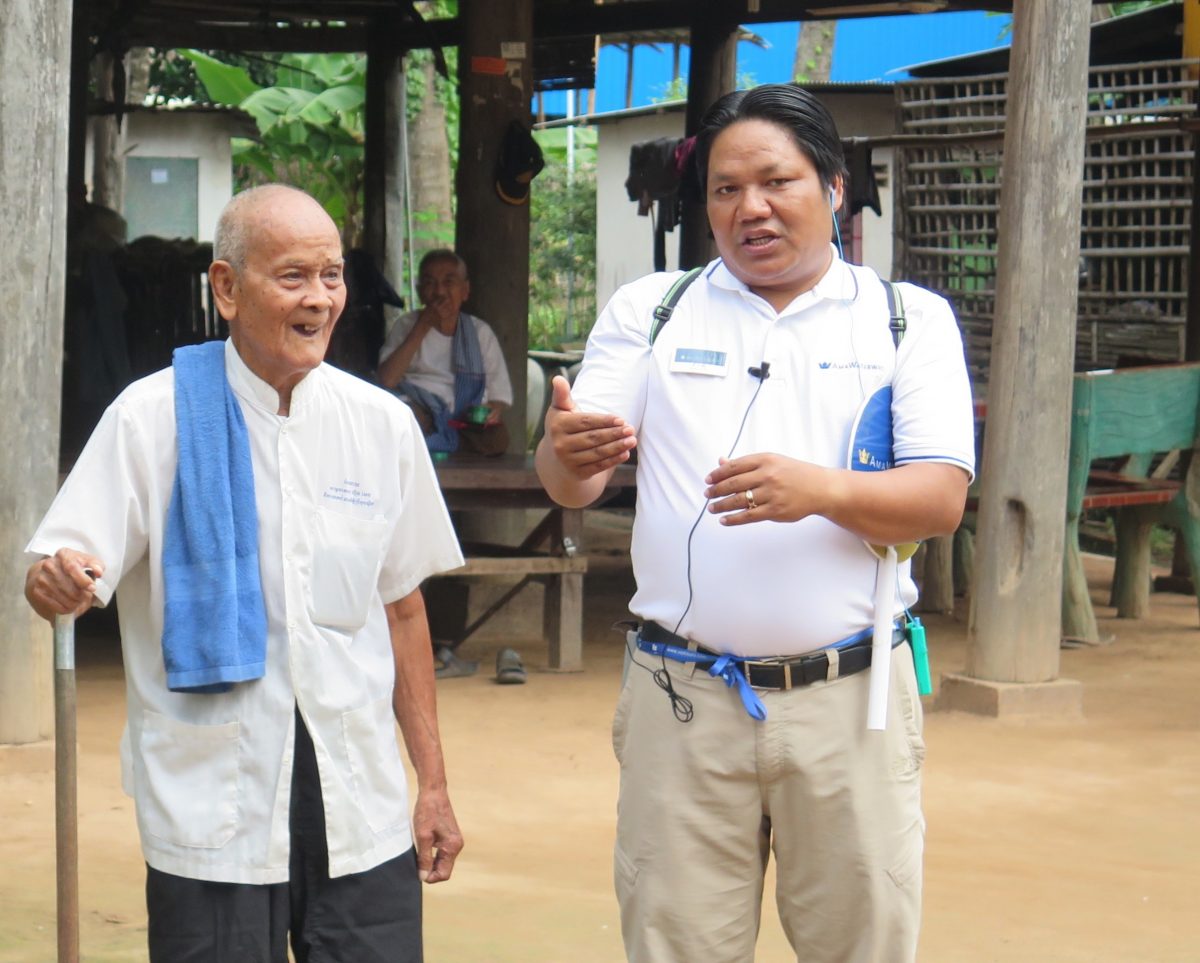
This Cambodian man invited us into his home. At right is AmaWaterways guide Fin. * Photo: Anne Kalosh
Day 8: Kampong Cham to Siem Reap
Goodbye, AmaDara. Hello, Angkor!
Capt. Tuc and all the crew lined up on shore to wish us farewell. It was sad to say goodbye to so many kind and charming people who’d cared for us with such wonderful hospitality.
We were handed box lunches for the four-hour drive to Siem Reap. Cornfields were juxtaposed with rubber trees, and motorcycles buzzed by with four or even five riders. As we arrived at Siem Reap, Fin’s home, he pointed out where, as a boy, he herded the family’s cows, walking carefully to avoid trip wires set by the Khmer Rouge. It was a chilling reminder of Cambodia’s not-so-distant holocaust.
Once a sleepy town, Siem Reap is now the bustling gateway to Angkor Wat, with an international airport and many fine hotels as well affordable and cheaper digs for budget travelers. Ours was the lavish Sofitel Angkor Phokeethra Golf & Spa Resort.
On an afternoon tour to Ta Prohm Temple, where giant trees grow from the walls, parrots and macaque monkeys broke the eerie silence. Angelina Jolie filmed “Tomb Raider” there.
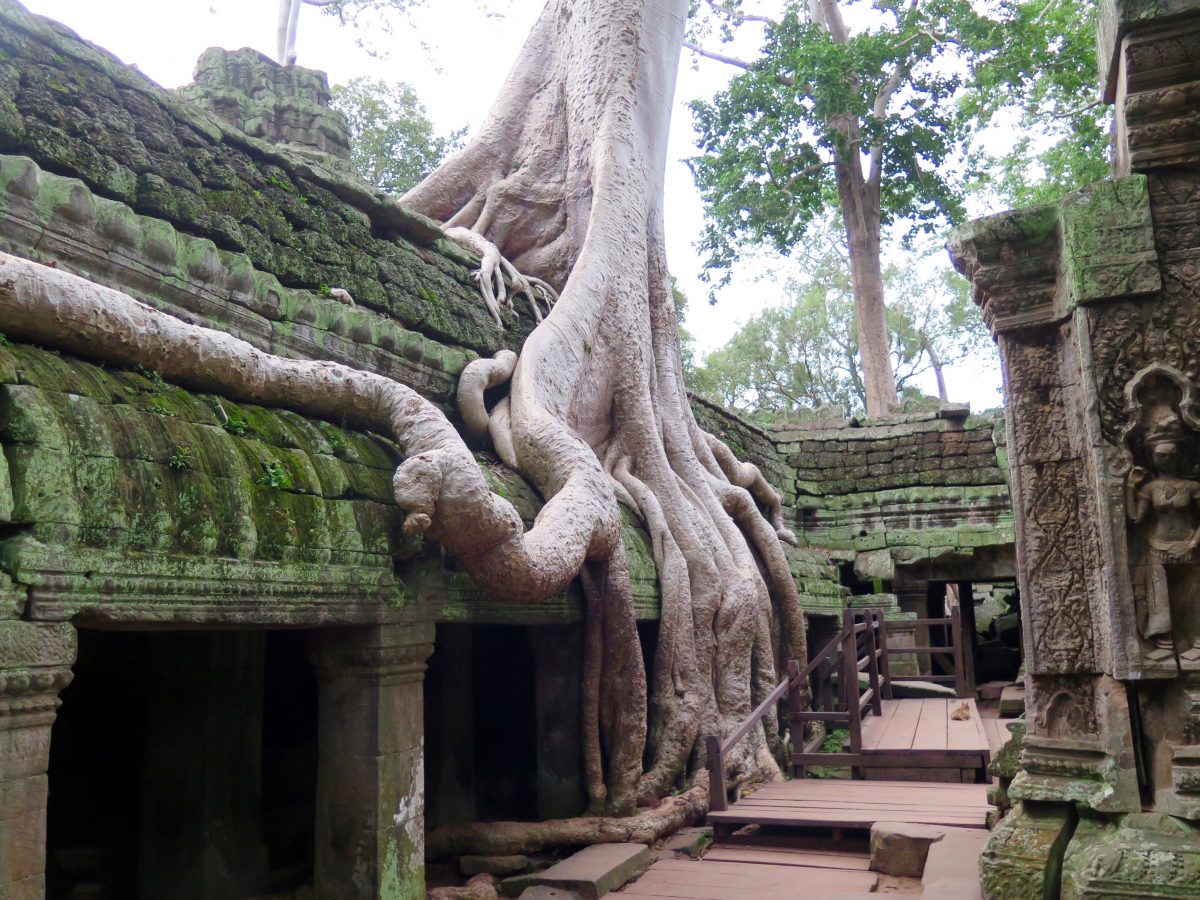
Trees grow from the walls at eerie Ta Prohm Temple in Angkor, Cambodia, which featured in Tomb Raider with Angelina Jolie. * Photo: Anne Kalosh
Day 9: Siem Reap
Sunrise at World’s Largest Temple Complex
Most AmaWaterways travelers spent two nights in Siem Reap. I had a noon flight so I opted for a sunrise visit to the ancient Angkor Wat temple complex. No rooster crowed at the posh Sofitel, but croissants awaited the 4 a.m. early risers in the Ama group. We joined the flow of pilgrims, walking with flashlights, over the causeway atop a wide moat. A light mist made things even more atmospheric.
There was no brilliant sunburst but the gradual unveiling of this incredible sight at daybreak was still profound. Besides its monumental scale and alluring shapes, Angkor Wat is fascinating for its dynamic bas-reliefs of scenes from Hindu epics and hundreds of dancers, each pair said to have different headdresses.
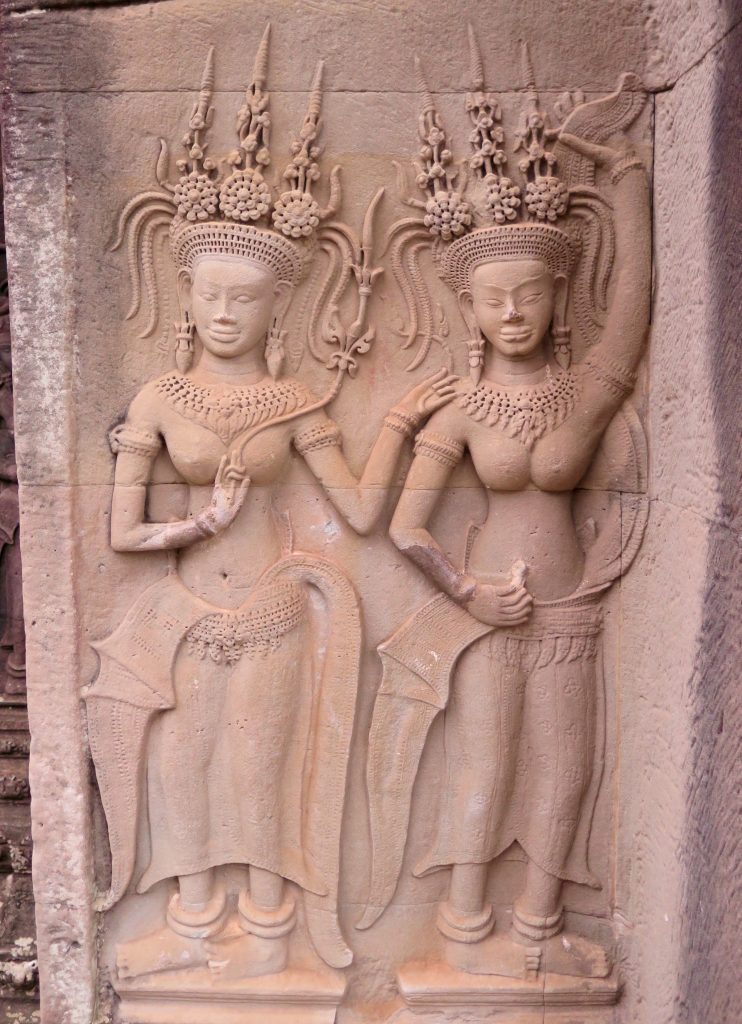
Angkor Wat is rich with thousands of well-preserved carvings. * Photo: Anne Kalosh
It was a climatic finish to a fascinating trip, from the vigor of Vietnam to the calm (decades after the Khmer Rouge storm!) of Cambodia. I learned and experienced a lot, and much of that was thanks to our excellent Ama guides.
When we’d first arrived in Cambodia, Fin taught us the sampeah, the traditional way of saying hello, goodbye, sorry and thank you by pressing the palms together and slightly bowing the head. The level of the hands is important, signifying different relationships. For example, friends of the same age place both palms together at chest level. When greeting bosses, older people or high-ranking people, the hands are raised to mouth level. Saying goodbye to Fin, I put my palms at nose level, appropriate for saluting a teacher.

If you’re lucky, this is Angkor Wat at sunrise. * Photo: Heidi Sarna
For booking info, contact AmaWaterways.
And here’s Anne’s interview with AmaWaterways Co-Owner Kristin Karst.
Don’t miss a post, subscribe to QuirkyCruise.com for monthly updates!
© This article is protected by copyright, no part may be reproduced by any process without written permission from the author. All Rights Reserved. QuirkyCruise.com.

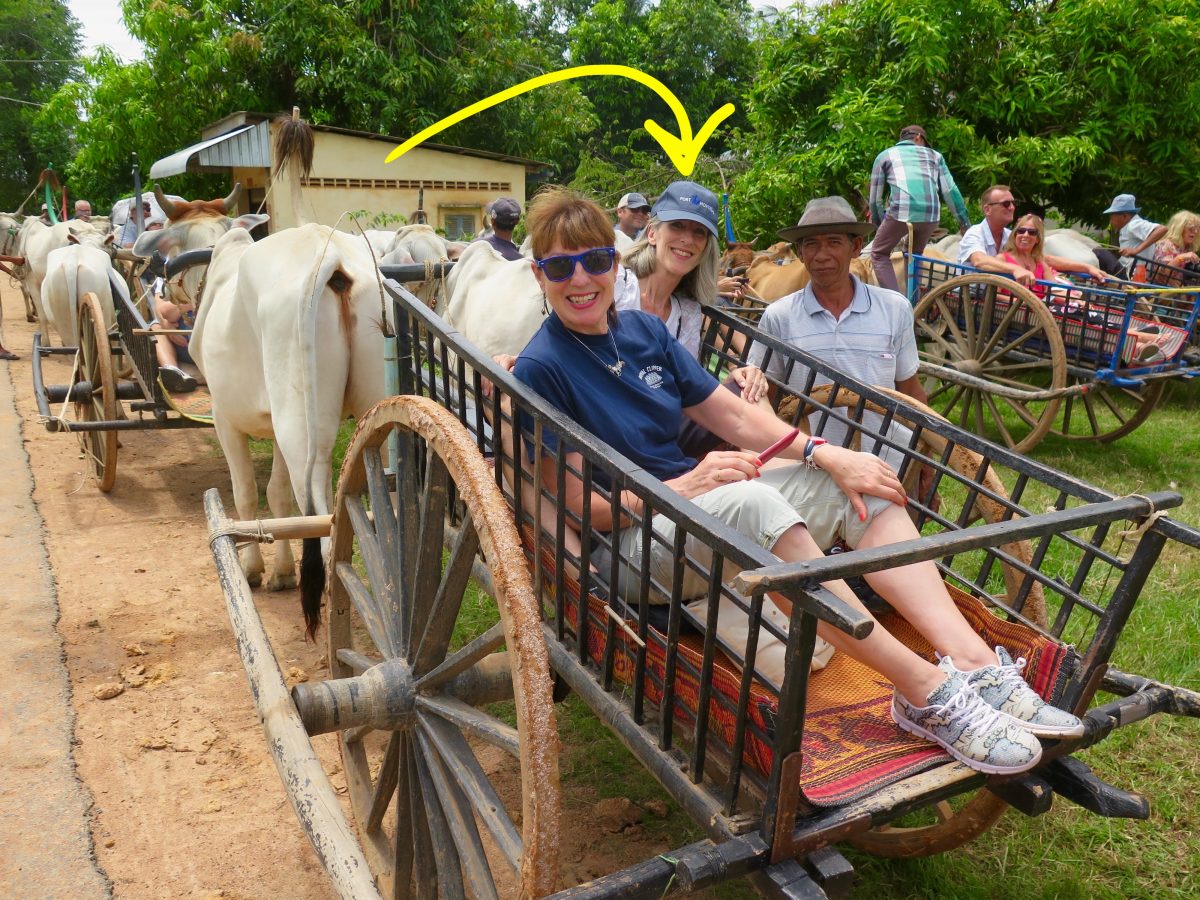
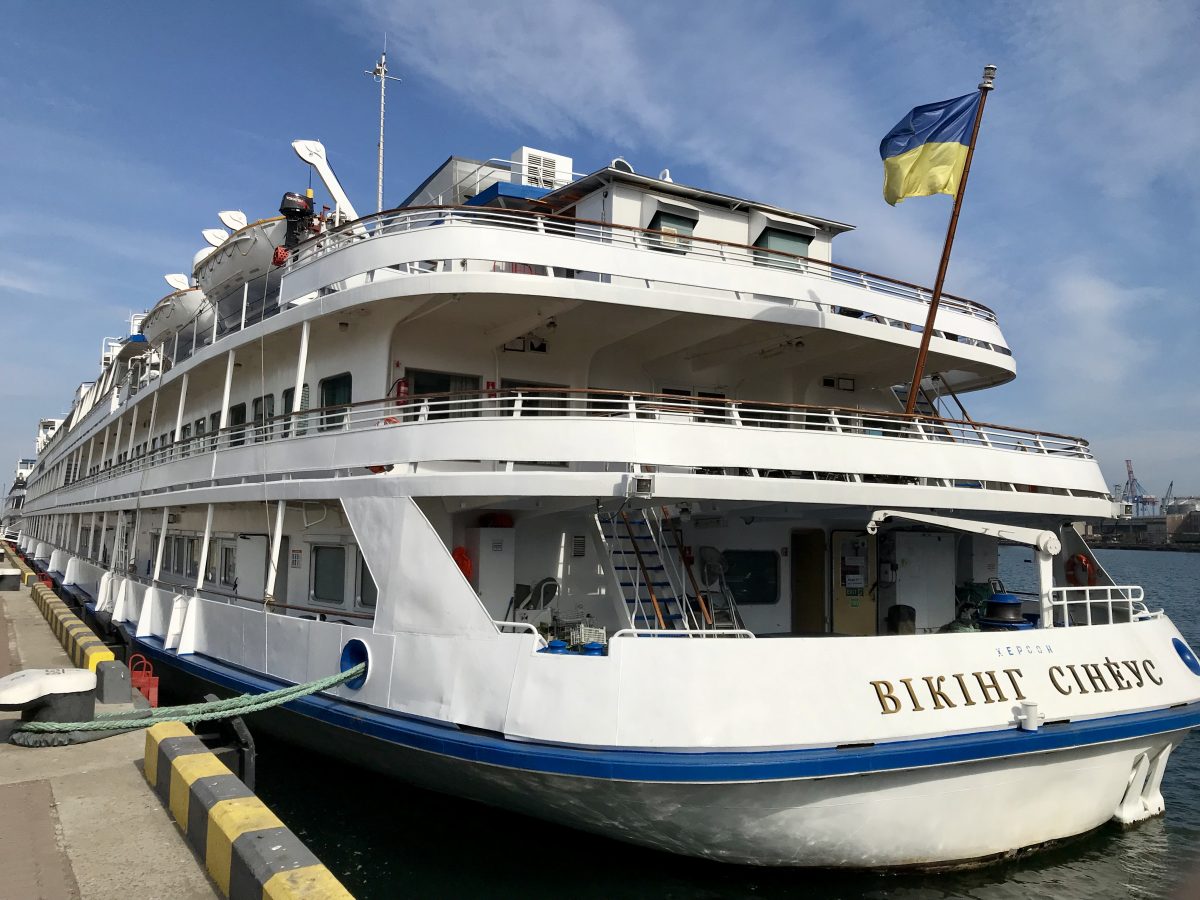
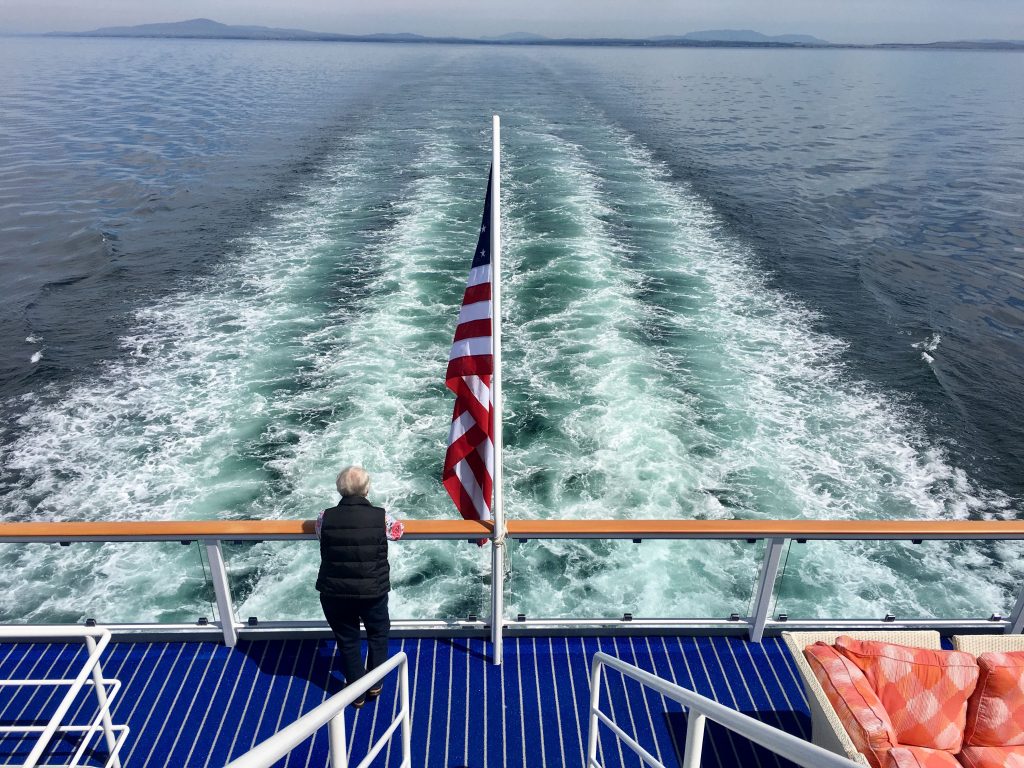
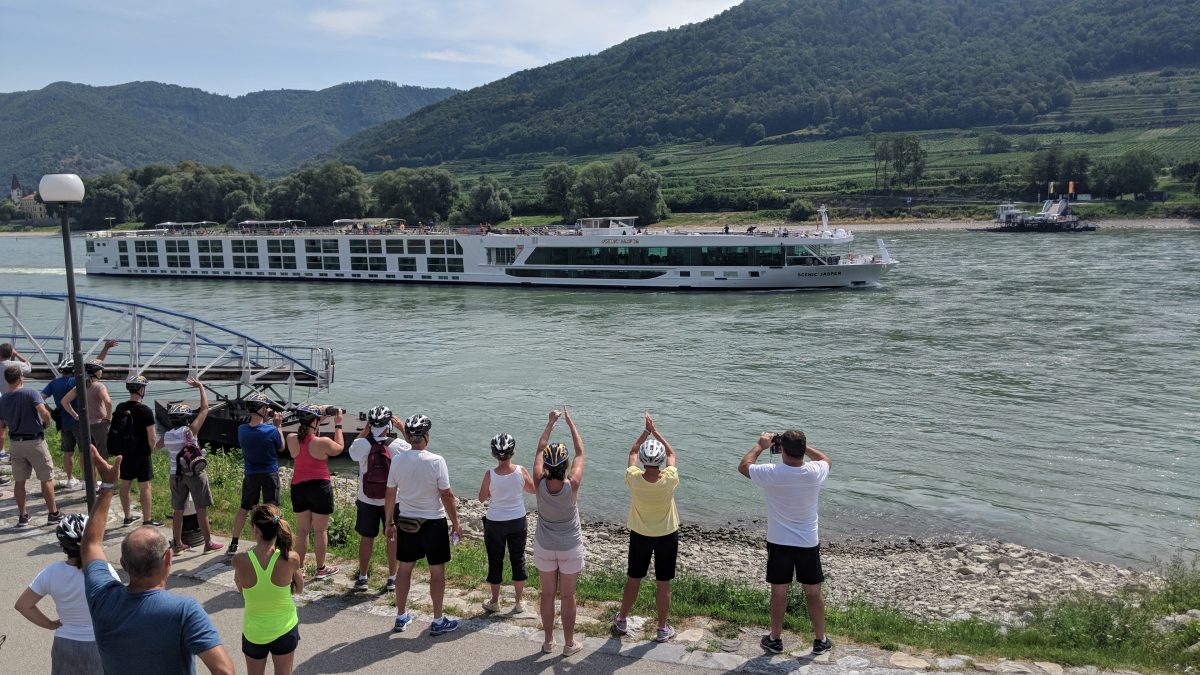
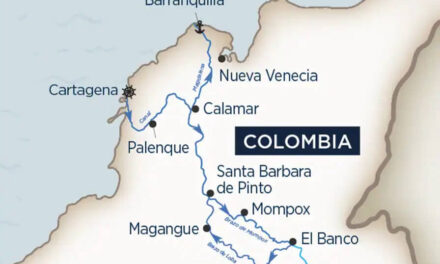








 HEIDI SARNA
HEIDI SARNA











